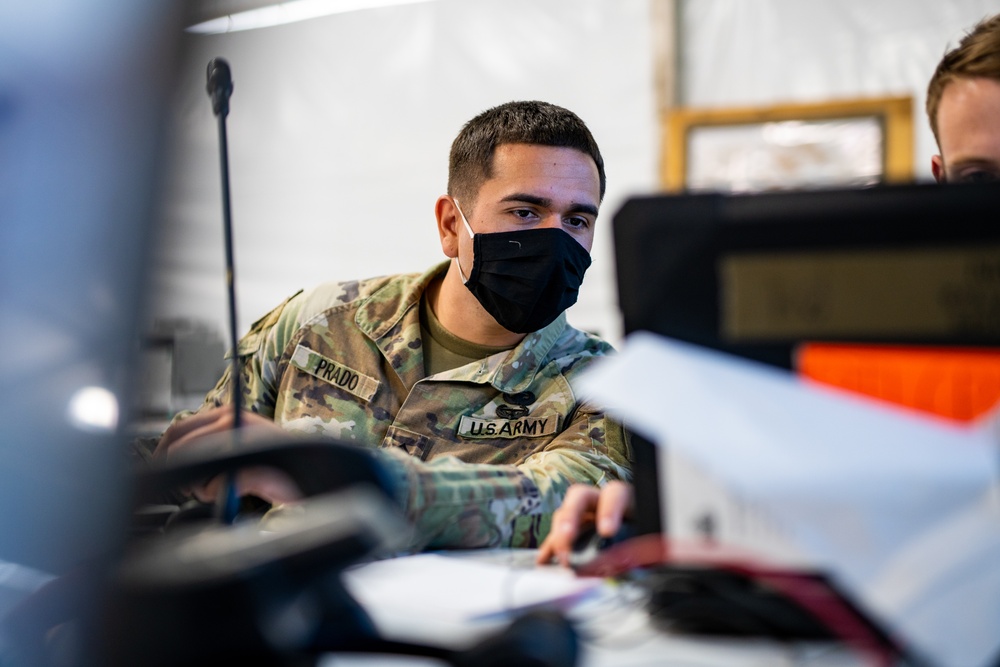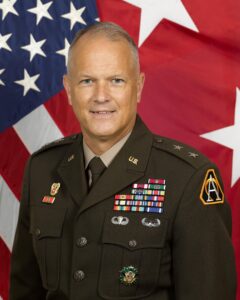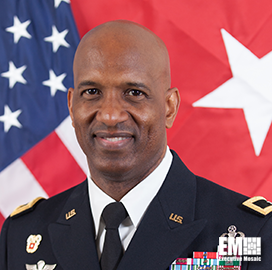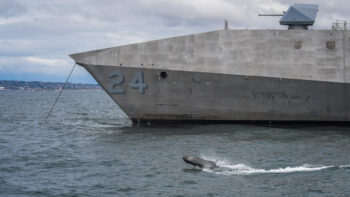
Paratroopers establish a communication strategy during the beginning of Project Convergence 21 in Yuma, AZ, Oct. 7, 2021. (U.S. Army photo by Pfc. Vincent Levelev).
Movement from network-centric operations to data-centric operations for communications and networking is one of the key enablers for all-domain operations and Joint All Domain Command and Control (JADC2). The goal is ultimately to provide single-pane-of-glass situational awareness for interoperability between joint forces and partners, via secure transport that will function during a Great Power challenge.
Last fall’s Project Convergence 2021 (PC21) was another stop on the path to JADC2, and was designed to stress test 100+ different technologies related to communications, networking, interoperability, and connecting sensors to shooters.
To discuss preliminary observations related to PC21 and other subjects such as satellite communications (SATCOM) for on-the-move communications, we talked with Maj. Gen. Robert Collins, program executive officer for Command, Control, Communications-Tactical (PEO C3T), and Brig. Gen. Jeth Rey, director of the Network Cross-Functional Team at Army Futures Command.
Breaking Defense: What was learned in Afghanistan about collaboration among the Army, Marine Corps, and coalition partners that will have direct applicability to helping realize all-domain operations in a Great Power competition?
Rey: A couple things in Afghanistan changed the dynamics of how we would actually interoperate with our partners on the ground. I was the CENTCOM J6 when I was tasked with collapsing a 20-year (network) architecture into one base, which was HKIA (Hamid Karzai International Airport). What that did was cause each of the individual services to go back on their organic, tactical communications capability.
What we learned is that interoperability (between) the joint forces and coalition partners needs to be a priority across all of our services to ensure that when we are put in a situation (like) HKIA that we can easily integrate collectively.
What I can tell you is that during Project Convergence (PC) we were able to actually overcome that in some of the use cases that we had on the ground where Army, Marine Corps, Navy, and Air Force were collaborating collectively across CPCE (Command Post Computing Environment) and our joint COPs (common operational pictures).

Maj. Gen. Robert Collins, program executive officer for Command, Control, Communications-Tactical (PEO C3T).
Collins: What we have learned across our joint warfighting construct includes everything from fires to command and control, to information and how we use it, and all the way to logistics. We’ve got to be able to do all those things across a multitude of domains: space, air, land, sea, and now within cyber. The JADC2 construct is the glue that pulls all that together.
The cornerstone of all of that is the data. We’re trying to transition from a very network-centric environment to understanding the types of data that we need to enable the joint warfighting construct. The HKIA mission that Gen. Rey mentioned underscored the need to make sure that we’re postured and ready for all aspects.
In addition, we will not only work within our service, we will work jointly, within a coalition environment, and within the whole of government. We have to be prepared to operate across that entire continuum.
Breaking Defense: That flows into the next question. You’re naturally invested in the Army’s Project Convergence, but how do you think — from a technological standpoint — that it will ultimately come together with the Air Force’s Advanced Battle Management System (ABMS) and others in a unified effort that can begin to provide some JADC2-type capabilities? I understand that formal results for PC21 are still pending, but what are your initial observations as they relate to JADC2?
Rey: In order for JADC2 to be realized, in order for us to share data and for sensor-to-shooter information to be at the point of need for the commander, a data fabric is going to be required. Moving to a data-centric environment is going to allow us to do that.
We also realized (at PC21) that transports are going to be something that is required in order to move around the massive amount of data. We need a transport-agnostic environment where we have multi paths through which information can move.
Another thing (we observed) is that in order to extend the tactical range of our network for both soldiers and Marines on the ground, an aerial-tier architecture is going to be required. We need some type of long-loitering capability overhead to provide range extension for our ground forces.
All of that is underpinned by a security architecture. We learned that multiple levels of security are required to move data from the strategic level down to the tactical level, and have that information still be available for them to execute on target.
Collins: What we’re recognizing working across the joint community is there may very well be multiple data fabrics. However, we’ll federate those within JADC2 and we’ll leverage things like reference architecture and implementation to help collectively link those areas together. The data fabric is going to be the underpinning and the horsepower that will help enable analytical engines and the visualization layer.
We identified two specific areas of what we would call a “single pane of glass” that we need to focus on: our all-domain situational awareness or common operational picture, and our engagement fires areas. To what extent can we work within the joint community to identify what are those interfaces and the minimum, essential areas that we need to agree upon to make sure that we can have common graphics, common overlay, and common terrain background?
To enable that, you have to have assured transport in a cyber-secure architecture. One of the areas we’re pulling on is not just PACE — primary, alternate, contingency, emergency communications — but the automated ability to implement that. Assured communications is going to be the underpinning of how we bring this all together.
Breaking Defense: We recently interviewed DoD Satcom chief Mike Dean and he said that low-latency satellite capabilities in proliferated low-Earth orbit (LEO) will now truly provide on-the-move communications and command and control, rather than depending on comms at the halt. What are you working on in this area, and how might you take advantage of a layered architecture in space that includes LEO, medium-Earth orbit (MEO), and geostationary orbit?
Rey: At PC21 we were able to use not only commercial but also military (SATCOM). We aggregated that bandwidth and then utilized it to move our data across the entire exercise. We know that LEO and MEO are going to be very important for us to gain a better on-the-move capability as we move out on Capability Set 23.
We are definitely looking forward to when those constellations are proven and stable enough for us to increase our on-the-move capability, which is something we’ve been trying to achieve for many years. We just have not been able to really cross that line and get there.
(Our goal is) transport-agnostic calls, 5G, LEO, MEO, and other bands in a PACE that’s automated and transparent from a user perspective as you move from one to the other.
Collins: Gen. Rey hit it spot on where we’re trying to get to the PACE piece. Within the SATCOM arena, making our terminals multi-functional with the ability to access a multitude of layers — LEO, MEO, or GEO — is where we’re headed.
We’re looking to create a family of terminals in the space arena so that we have common capability and a building block of SATCOM terminals that you can build upon depending upon what echelon that you’re at.
The other thing that we’re looking at is the way we acquire our satellite assets. Traditionally we buy blocks of capability, which may or may not get utilized. As we go into these multiple layers of capability, we want to (move toward) SATCOM-as-a-service so that you can acquire only what you need. That’s one area that we put a request for information out to industry to look at better ways to participate in SATCOM.
Traditionally, we’re very comfortable in GEO. But now MEO is probably very close to being leveraged. And in LEO, once we make sure that we’ve got the appropriate coverage, it’s going to be another tool in the toolkit that we can leverage to ensure assured communications for the warfighters.























